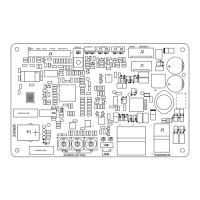BAS-SVP09B-EN 13
BCI-R Operation
The control system on HVAC equipment has the ability to operate the unit as a stand-alone system
or as part of a building automation system (BAS). The BCI-R (either factory or field installed), by
default, is configured for stand-alone operation. This configuration enables the HVAC equipment
to operate prior to the commissioning of the unit into the BAS.
BAS Unit Control
The BCI-R operates by using setpoints and placing points in and out of service. This method
consists of BACnet objects that the BAS can access to control and monitor the status of equipment.
Initiating System Control
To initiate system control:
1. Make binary output 1 (BO 1), system control command, acti
ve.
Trane also recommends setting the relinquish default value to active when performing step 1.
Note: BO
1 must in service in order to control from a BAS.
Important: y
ou must make BO 1 active in order to receive commands from the BAS system
control. If inactive, only montioring and status are allowed. BO 1 is often referred to
as the “master switch.” See Tab le 8, p. 29.
2. Place in service the output points that are required by your application.
Note: Th
e output points to be placed in service are dependent on the job, the unit
configuration, and customer preference. The following list is an example of common
output points that might be placed in service for constant volume (CV) units.
• Mu
lti-State Output 7, Occupancy Request
• Multi-State Output 8, Heat Cool Mode Request BAS
• Multi-State Output 2, Emergency Override Command
• Analog Output 2, Space Temperature Setpoint BAS
• Analog Output 29, Occupied Offset
• Analog Output 30, Standby Offset
• Analog Output 31, Unoccupied Cooling Setpoint
• Analog Output 32, Unoccupied Heating Setpoint
• Analog Output 9, Space Static Pressure Setpoint BAS
Output and Input Object Data Points
• Output objects; used by the BAS to provide command, setpoint, and sensor information to the
rooftop unit. By default, most output objects are placed out of service to allow standalone unit
operation before commissioning. See Tabl e 3, p. 24, Tab le 6, p. 27, and Tabl e 8, p. 29 for details.
• Input objects; provide ReliaTel status information to the BAS. See “Object Data Points and
Diagnostic Data Points,” p. 24, for a list of supported objects. By d
efault, all input objects are
placed in service to allow monitoring of unit operation, even in standalone mode, before
commissioning.
See Tab le 4, p. 25, Tab le 7, p . 27, Ta bl e 9, p. 29, and Tabl e 10, p. 30 for more
details.
You can define the amount of control that the BAS system will apply to the unit. This is done by
configuring the state of the Ou
t of Service property of the output objects. If the property is set to
True , the equipment will use a corresponding local value for control. If the property is set to False,
the local value is ignored and the BAS-supplied value is used for control. The BAS value is provided
to the rooftop unit by writing to the present value property of the corresponding output object. The
factory default value for the Out of Service property of these objects is True.

